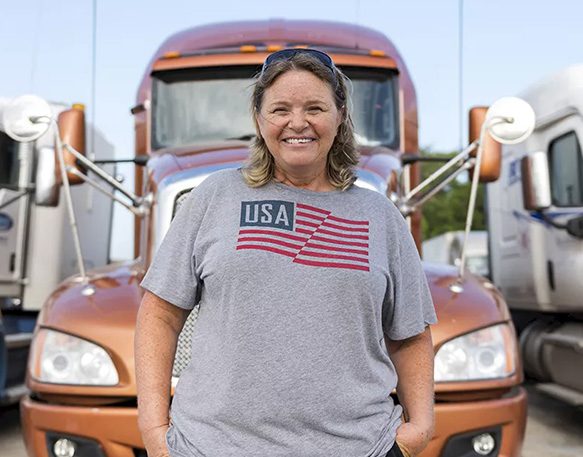If you’re looking to grow your business as a carrier or owner-operator, less-than-truckload (LTL) loads can be a great option. They provide the flexibility many shippers need to get goods from one point to another, making them a popular choice that helps keep truckers on the road year after year. Plus, the potential for growth in this sector is high, with e-commerce creating a surge in LTL freight as more and more people shop online. This growing demand for faster, more efficient shipping is creating a need for more LTL carriers—a perfect opportunity for those looking to enter the trucking industry.
However, as with any type of freight, the opportunities that LTL trucking loads bring to LTL carrier service providers are accompanied by several challenges you’ll need to navigate if you decide to join the ranks of LTL trucking companies. Fortunately, with the right tools and technology, you can deliver LTL loads effectively and build a healthy company that sees success in both the short- and long-term.
In this guide, we’ll explore the basics of less-than-truckload freight so you can answer the question, ‘What is LTL freight in freight shipping?’ Then, we’ll cover how to find great LTL loads using the DAT load board, build a partnership with an LTL broker, and earn repeat business as an LTL truck freight provider.
What is LTL freight?
LTL loads are exactly what they sound like: they’re loads that don’t fill an entire truck. More specifically, LTL loads refer to shipments that typically weigh between 150 and 15,000 pounds. They’re large enough to have some bulk that requires specific LTL freight carriers equipment and professional handling, but, at the same time, are not big enough to fill out the full capacity of a trailer.
If you’re worried that you might not be able to fill up a truck with multiple LTL loads, don’t stress. LTL loads make up about 6% of loads found on the DAT load board. That means there’s ample opportunity to find and secure great LTL carrier loads near you.
How is LTL freight different from other types of freight?
So, how exactly is LTL freight different from other types of freight? Let’s take a look. When you transport less-than-truckload freight, you’ll:
- Reduce deadheading: Truckers dread deadheading, and LTL carrier loads help carriers avoid the risk of hauling nothing down the highway. You can haul multiple less than truck loads at once and build relationships with customers quickly. Even if you can’t necessarily fill up your truck fully on a backhaul, with LTL freight you’re less likely to have a completely empty trailer. That’s just one of the reasons why LTL loads can actually get you more money from a per-pound standpoint compared to conventional loads.
- Deal with frequent truck rearrangement: Many LTL loads come packaged on pallets for improved durability. That increased support is critical given that carriers often need to take LTL freight shipping loads on and off trailers multiple times before arriving at their destination. You can think of a trailer as holding a giant Tetris puzzle. LTL loads fill those spaces that would otherwise remain open. The puzzle changes a bit as loads are dropped off.
- Become a time-management pro: LTL freight carriers are masters of managing the clock. Because they’re hauling freight for multiple customers to many destinations, they must anticipate and communicate to shippers and customers alike about anticipated time of arrival and delivery. This type of ongoing dialogue can help an LTL carrier win the trust of partners more quickly because this type of complex hauling and delivery requires extra TLC. The best LTL trucking professionals are masters of this kind of business relationship-building.
- Be able to offer a white-glove treatment: Because of the compact nature of LTL loads, some customers might want you to take a more hands-on approach to freight. Instead of dropping product off at a loading bay, you might be unloading it and then taking it into a building or facility. You might even use a liftgate as part of the process. Taking these extra steps is different from unloading a full trailer load, but it can demonstrate your attention to detail and ability to keep freight safe from Point A to Point B. In some cases, you might also be able to charge more for these services.
How can I find LTL loads near me?
As you build your LTL trucking business, you’ll want to find high-quality LTL carrier loads to deliver. The best option for locating less than truckload shipping loads you’re qualified to carry is to use a load board.
If you’re looking to find the most quality LTL loads, there’s no doubt that the DAT load board is the best place to do it. With the DAT load board you can conduct custom searches to quickly find loads to haul, trustworthy partners to work with, and market data to help you negotiate rates. No matter what load board you use, here are some tips to help you find top quality LTL freight:
- Search for less-than-truck loads that match your equipment: The best load boards will let you perform customized searches where you can input your vehicle details and find the freight that matches. Given that LTL freight can be transported by multiple vehicle types, you can reduce the time spent scrolling past freight that doesn’t match your needs by using a load board that lets you input vehicle details, like the DAT load board.
- Study the marketplace to negotiate for top rates: A great resource, such as the DAT Market Conditions Index, can help you track supply and demand for freight and even predict future changes. By studying the average market rates, you can price your services to match current rate trends and ensure you aren’t asking for too much or too little during negotiations. Additionally, you can use a freight class calculator to determine the LTL freight class. Freight class is a major factor in pricing shipments of this kind, so knowing where your shipment falls can make all the difference when negotiating the right price. All this will better prepare you for conversations with brokers and equip you to make a winning bid.
- Assess customer criteria: Not all shippers and brokers are created equal. With a top load board, you’ll be able to see key information about potential partners before you work with them, including information on their credit history, average days to pay, and more. You can even read reviews from other carriers who’ve worked with them in the past to see if they seem like a good fit. This information can guide your decisions and help you secure a winning load for successful less-than-truckload shipping.
- Schedule alerts to find future LTL loads: Working as an LTL carrier means finding more loads than you might if transporting full truckloads. The problem is that you don’t have time to spend on an LTL load board 24/7. Luckily you don’t have to when you use a quality LTL load board, like the DAT load board, which lets you save searches and set alerts for loads that match your criteria. That way you can be confident you’ll know as soon as a new load you could haul is posted without wasting time staring at the board.
What are the benefits of LTL freight?
Beyond knowing what is LTL freight, it’s also a good idea to understand why you might haul LTL freight. Benefits of transporting LTL freight include:
- Reduced environmental impact: By consolidating shipments and minimizing empty space on trucks, you can lower your fuel consumption and emissions, which could reduce your environmental impact.
- Reduce or eliminate deadheading: When you take on LTL carrier loads, you can significantly reduce the amount of time you spend driving with no loads. After all, you’ll have multiple smaller loads simultaneously, so chances are you’ll always have some freight to deliver, minimizing those empty miles.
- Stay profitable: Thanks to your reduced fuel consumption and deadheading, you can stay efficient, increase profits, and keep more of your revenue in your pocket.
- Diversify clients: By taking on a larger number of clients with smaller loads, you can reduce your independence on any single customer, improving stability during fluctuations and resulting in a more resilient business.
When should an organization use LTL freight shipping?
Every LTL carrier has a system for effectively hauling less-than-truck loads. While many choose to navigate the freight dispatching process on their own, using an LTL freight shipping partner will give them more time and energy to focus on transporting loads instead of finding and negotiating freight.
More specifically, an LTL broker can help your carrier business because they:
- Save you time and energy when it comes to tracking down ideal loads, instead creating connections and opportunities with their shippers and negotiating deals that work for both parties.
- Build a relationship with your business and know your equipment, lanes and hauling criteria, meaning they’ll always find loads that match your interest.
- Locate loads that will bring you great pay, of which they’ll only take a percentage as compensation for their services.
How can I earn repeat business as an LTL carrier?
Customers that regularly have products that require less-than-truckload shipping are the kind of business you’ll want to work with again and again. These shippers need carriers with the flexible capacity and schedule that LTL truckers can provide. They also want carriers with a track record of dependability and delivering goods safely.
To earn repeat business, you first need to demonstrate that you are a partner worth working with again and again. While there’s no specific formula to guarantee repeat opportunities and long-term contracts, following these steps can improve your chances:
First, do background research on each shipper before you even bid on a load. Understand the customer’s goals, products, and history. Do they mesh well with your experience and equipment? Do they pay well and on time? Do they frequent the lanes you know best? If you can answer yes to some or all of these questions, you might be well on your way to hauling multiple loads for that customer. With the DAT load board, you can find all that information right at your fingertips.
Next, once you take on a load, do what you promise. Treat each LTL carrier load with care. One of the challenges of LTL cargo can be a tendency for damage to occur because loads are placed onto trailers and removed from them over and over before reaching their final stop. Use the right equipment, understand what success looks like to the client, and commit to delivering with excellence every time. Once the load is delivered, follow-up to confirm delivery and that everything is as expected. Your customer will be happy, you’ll get paid, and you’ll have teed up the potential for a long-term relationship.
Finally, take time to post a review on the DAT load board. Not only will your customer appreciate kind words about a positive experience, but you’ll also establish yourself as an experienced LTL carrier among your peers in the industry. Adding to the collective knowledge of the LTL trucking community positions you as a growth-minded carrier looking to make a difference.
Elevate your LTL freight services to the next level
Less-than-truckload loads have plenty to offer carriers looking to grow their businesses. Not only does LTL help truckers reduce costly deadheading but it also helps carriers maintain steady revenue streams by filling empty trailer space with multiple smaller loads. On top of that, taking on smaller loads enables you to work with more clients, fostering growth, diversity, and stability in your business partnerships.
By taking on LTL freight shipments, you can diversify your offerings, boost profitability, and provide flexible solutions that keep your clients coming back. However, you need the right tools on your side to find quality loads and partners and negotiate the rates you deserve.
Find the best LTL freight with DAT!
As the largest freight marketplace in the industry with more than 644,500 new posts each business day, the DAT load board is the best place to find LTL freight that matches your interests. With data on any lane, broker and shipper information to help you build trustworthy partnerships, simple searches and alerts, and so much more, the DAT load board is the perfect tool for LTL carriers. Try it out today!




